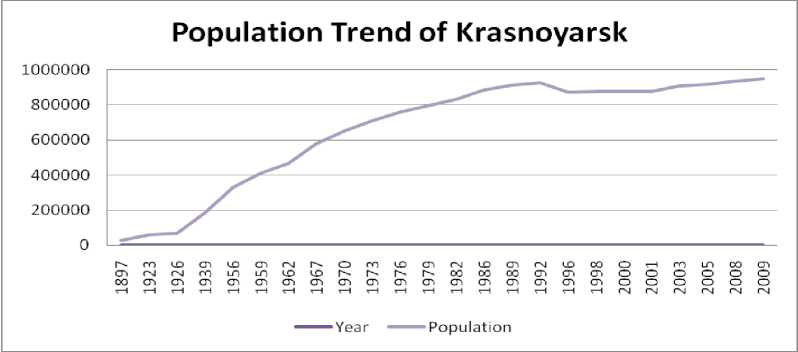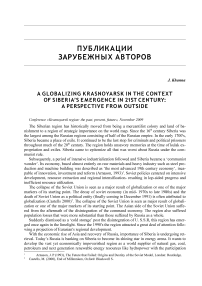Krasnoyarsk in the context of Siberia's globalization in the 21st century: a perspective from the outside
Автор: Khanna Dr. J.
Журнал: Вестник Красноярского государственного педагогического университета им. В.П. Астафьева @vestnik-kspu
Рубрика: Публикации зарубежных авторов
Статья в выпуске: 3 (11), 2009 года.
Бесплатный доступ
Krasnoyarsk is one of the most ancient cities in Siberia. As a result of globalization, this city has become a center of multinational culture. Here, in addition to the Russians live Ukrainians, Tatars, Germans, Belarusians, as well as Tajiks, Uzbeks and representatives of other peoples. Today Krasnoyarsk is a large industrial center of Russia. The economic restructuring taking place in the region affected this city as well. And the transition period did not always flow smoothly in the main city of the region and in the province itself. Privatization of factories and factories resulted in a dramatic increase in unemployment and strikes in enterprises. Thus, the global changes taking place in Siberia are directly reflected in the nature of the development of Krasnoyarsk.
Socio-economic transformations, globalization, aftermath of disintegration, dichotomy, rise in unemployment, privatization, multi-ethnic, immigration
Короткий адрес: https://sciup.org/144159016
IDR: 144159016
Текст научной статьи Krasnoyarsk in the context of Siberia's globalization in the 21st century: a perspective from the outside
Conference «Krasnoyarsk region: the past, present, future», November 2009
The Siberian region has historically moved from being a mercantilist colony and land of banishment to a region of strategic importance on the world map. Since the 16th century Siberia was the largest among the Russian regions consisting of half of the Russian empire. In the early 1700's, Siberia became a place of exile. It continued to be the last stop for criminals and political prisoners throughout much of the 20th century. The region holds unsavory memories at the time of kulak expropriation and exiles. Siberia came to epitomize all that was worst about Russia under the communist rule.
Subsequently, a period of intensive industrialization followed and Siberia became a ‘communist wonder’. Its economy, based almost entirely on raw materials and heavy industry such as steel production and machine building was described as ‘the most advanced 19th century economy’, incapable of innovation, investment and reform (Arnason, 1993) 1. Soviet policies centered on intensive development, resource extraction and regional intensification- resulting in lop-sided progress and inefficient resource utilization.
The collapse of the Soviet Union is seen as a major result of globalization or one of the major markers of its starting point. The decay of soviet economy (in mid- 1970s to late 1980s) and the death of Soviet Union as a political entity (finally coming in December 1991) is often attributed to globalization (Castells 2000) 2. The collapse of the Soviet Union is seen as major result of globalization or one of the major markers of its starting point. The Asian side of the Soviet Union suffered from the aftermath of the disintegration of the command economy. The region also suffered population losses that were more substantial than those suffered by Russia as a whole.
Suddenly dismissed as a ‘cold storage’ post the disintegration of U. S.S.R, this region has emerged once again in the limelight. Since the 1990's the region attracted a great deal of attention following a projection of Eurasian's regional development.
With the economic rise of Asia and recovery of Russia, importance of Siberia is undergoing retrieval. Today’s Russia is banking on Siberia to become its shining star in energy arena. It wants to develop the vast yet economically impoverished region as a world supplier of natural gas, coal, petroleum and next generation renewable energy resources like hydropower with the participation of the global powers. Another related plan is to develop connections to the ‘mainstream’ world by the way of transcontinental railway lines. This way it attempts to bring the market closer to the isolated Siberia. The development of Siberia’s resources could develop as a threat or promise for the entire planet. With the dynamic environment in place, Siberia’s identity3 has undergone a change. Prof. Lounev referred to Siberia as Russia’s Amazonian. Just as the Amazon region is the world’s lungs, Siberia is a resource rich region of immense utility to the world. Siberian region is known to be the storehouse of mineral and energy resources with scanty manpower.
Russia and Siberia’s Unique Experience of Globalisation
Gustafson (1999) 4 talks of ‘Capitalism Russian Style’. He talks about Russia’s unique experience with Globalization. He discusses Russia’s complicated and partial connection with global capitalism. Russia after transition had its own local dynamics and processes which refuse to fit into a homogeneous global mould.
Makarychev (2000) 5 analyses the effect of globalization on Russia’s federal structure. He notes the formation of ‘Islands of Globalisation’ in Russia. He observes that sub- national territorial units in Russia are gradually becoming international actors (case in point Kaliningrad). Second, globalization of Russia’s regions is a very uneven and competitive process; third, this unevenness and competitiveness might bring both new opportunities and challenges for Russia.
For ordinary Russians, the experience of globalization has come by means of and as a consequence of glasnost and the subsequent collapse of the authoritarian Soviet state that had previously strictly controlled its citizens ‘access to the rest of the world. Ordinary Russians ‘experience of the collapse of the soviet union has been inextricably intertwined with a growing inter – connectedness and awareness of other parts of the world, in other words, with globalization and the transformations of the glasnost era coincide to such a degree in the Russian federation that most citizens do not – cannot – distinguish between the two.
Ordinary citizens look back with mixed feelings to the days when the state had a greater role to play in their lives. They look back in nostalgia when it comes to provision of critical services e.g. medical facilities, which were totally free but now they have to pay exorbitant amounts, education-The days of free state provided education are gone, Russians need to pay to the institute. The problem of narcotics and alcoholism has increased to a huge extent. Especially in metropolises like Moscow and St. Petersburg, there is a huge difference between the rich and poor, the generational moguls who had built for business empires find themselves nowhere. There is a general feeling that the people who were/are the state puppets are richest now. «A rich brat will spend thousands of roubles on chocolate or casinos». Therefore the access to power and money has become pronounced reasons for affluence. This leaves the general populace full with anger and angst due to this inequality. The profession, efforts, qualifications or utility of profession to the society does not de-
termine wages and social conditions. Doctors and teachers are paid less . «A person who is a PhD in medicine works for 24 hrs is gets less than the son of the ‘state person’».
Effects of Globalization on Siberia: Focus on Krasnoyarsk
The Siberian region has undergone marked socio-economic transformations since its early history as a scattered semi- nomadic tribal- dominated region, colonized for fur requirements of the European part of Russia. The Asian side of the Soviet Union suffered from the aftermath of the disintegration of the command economy. The region is undergoing its unique experience of globalization. Few areas of the Soviet Union suffered from the aftermath of the disintegration of the command economy as much as the Asian side of Russia did, due to its marginal economic situation, lack of adequate infrastructure, severe shortage of social services and other amenities and extreme climates. At the same time, new, transforming Russia began to open its doors to foreigners, even into such «forbidden cities» as Vladivostok, which was off- limits even for Soviet citizens until 1992 (Bychkova, 2004) 6. As the venue of the 2012 APEC summit, the grand task has been set: to build the new, modern city of Vladivostok – the pearl of the Far East.
In contemporary times, Siberia is facing dichotomy between becoming a region of global importance and representing Russian might. It is a region with ethnic heart yet modern ambitions and appears to be neglected region yet an emerging one. Siberia is the future focus of the world is its scientific-technological resources: its concentration of academia and students devoted to specialized scientific disciplines, universities and a resource-based economy.
«We simply mustn't waste this chance», Russia’s President Vladimir Putin declared in Akadem-gorodok following his 2005 trip to India. Siberia’s other resources are tough to tap, but cashing in on the 200,000 science and technology- graduates that Russia churns out each year, Kremlin can plan ahead about developing the Siberian region. In another instance, President Putin at a press conference for the Russian and Foreign Media held in January 2006 reaffirmed his faith in the people of the region: «I am sure that given the high level of education in Siberia, and also the purity there, the moral purity, Siberia's human resources will be of great importance for the country».
Even today, reputed institutions in pure sciences, engineering and technologies remain to be organized in Siberia. It has been home to the Science complexes of Academy of Sciences of the U.S.S.R, Academy of Medical Sciences of USSR, Lenin All Union Academy of Agricultural Sciences, present day Russian Academy of Sciences (RAS), Russian Academy of Medical Sciences (RAMS) and Russian Academy of Agricultural Sciences (RAAS). Universities at Irkutsk and Tomsk are one of the oldest and most respected universities.
More than one fifth the size of the United States, Krasnoyarsk province is well-endowed with vast reserves of coal, minerals, timber, oil and gas. It is also an industrial center with huge steel and aluminum plants that augmented the strength of Soviet military. Krasnoyarsk is also one of the earliest settlements of Siberia and one of the most progressive ones in the region. First founded in 1628 as a fortress by Cossacks, Krasnoyarsk has played the role of a frontier post since the past century. During its existence it was never conquered. Discovery of gold accelerated the economic progress of this region. After the Russian Revolution of 1917 as mandate of centralized planning ( pyatiletkas ) numerous large plants and factories were constructed in Krasnoyarsk including a major dock-yard ( Sibtyazhmash ), paper factory, hydroelectric power station (now the 5th largest in the world and the 2nd in Russia), and river port.
The Krasnoyarsk Hydroelectric Power station is one of the biggest hydroelectric power stations in the world with an installed capacity of 6,000,000 KW and is one of the biggest hydroelectric stations in the world. This station is rising further upstream on the Yenisei where the river cuts through a narrow gorge in the Sayan Mountains. The middle Yenisei hydroelectric power station is slightly downstream where it receives the River Angara. These two feed off the Central Krasnoyarsk Industrial Complex.
Krasnoyarsk in the 1970s was the nucleus of territorial production complexes going up around it, expanding on its periphery so the range of natural resources determining its production pattern. Krasnoyarsk began to develop at a particularly rapid rate during the Great Patriotic War when it was chosen as a site for some of the enterprises, mainly engineering plants which had been evacuated from European part of the country. Among these resources are the exceptionally inexpensive brown coals mined in open cuts (prime cost less than a ruble per ton in some cases) which are used as fuel for thermal power stations and hydropower of Yenisei River.
After the collapse of the Soviet Union and beginning of the privatization many large plants and factories, such as the Krasnoyarsk Aluminum Plant, many became owned by alleged criminal authorities and oligarchs while others were declared bankrupt. Notably, in November 1999 the Hungarian authorities and Interpol arrested Anatoly Bykov, a Krasnoyarsk tycoon, who controlled the largest Russian aluminium processing factory and a number of industrial enterprises in Krasnoyarsk. Bykov was seen as the most influential rival to Alexander Lebed, the governor of Krasnoyarsk krai, who pledged to bring him to court on charges of extortion, money laundering and financial fraud. Besides, the rise of the regional elite, the economic transition resulted in a dramatic rise in unemployment and numerous strikes.
Today, Krasnoyarsk is a major industrial complex, timbering town and one of the largest producers of aluminum in Russia. Interestingly, Krasnoyarsk is also known as the first region in Russia to use Internet technologies for public relations.
Another stark change has been in the demographics of the region. Krasnoyarsk has become multi-ethnic and cultural as a result of globalization. Besides Russians, Ukrainians, Tatars, Germans, and Belarusians, the number of Tajiks, Uzbeks and other Central Asian and Caucasian peoples has grown extensively because of the extensive often illegal immigration in search for work. Another populous immigrant group is the Chinese who, unlike other foreign workers, who are generally traders. This constitution of productive population of the region will be instrumental in determining the future face and social structure of the region. The in-migration has led the population trends in Krasnoyarsk to show a general rise (see Graph 1) as compared to Russia which show a decline in numbers especially in post- transition period (see Graph 2).

Graph 1
Source:,
149,000
148,000
147,000
146,000
145,000
144,000
143,000
142,000
Numbers
Mid Year Population estimates: 1999-2003

Time (1994-2003)
Graph 2. Population Trend for Russia (1994–2003) in 1000's
The Governor of Krasnoyarsk Region Alexander Khloponin, while discussing issues of Comprehensive Regional Social and Economic Development Programmes with Vladimir Putin in 2006 mentioned one of the systemic barriers: «The need for clear definitions is particularly important in a federation such as ours where there is a division of powers between the federal and regional authorities. This is a big country and each part of the country – the European part, Siberia, the Far East – should have its own specific development situation, its own guidelines. It is clear, for example, that we cannot develop the car-making industry in Siberia because we are too far away from sales markets, but it is equally clear that Siberia is a valuable source of energy resources, raw materials and high technology. Siberia also offers opportunities for developing mainline transport routes. And we need to plan our labour resources accordingly».
Siberia’s changing landscape in the global and regional spheres is affecting the development of Krasnoyarsk and its self- image. It remains to be seen how the aspirations of its people will frame the social, political and economic identity of a truly unique region of the world.


